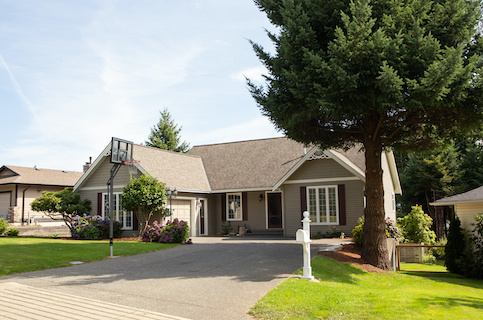Homeowners usually refinance to save money with a lower interest rate or a new loan term that reduces the monthly payment. However, to get those savings, you must pay closing costs between 3% and 6% of the loan amount. A key way to figure out if the savings are worth the cost is to calculate your break-even point, which is how long it takes for your savings to exceed your costs.
Key Takeaways:
- The break-even point of a refinance marks how long until the money you’re saving outweighs the costs of the refinance.
- You can calculate the break-even point by estimating your refinancing costs and dividing it by the amount you’re saving each month.
- Figuring out your break-even point is essential when deciding whether refinancing is good.
What Is The Break-Even Point?
The break-even point is how long it will take to recoup the upfront costs of refinancing your mortgage.
It works like this: Most homeowners refinance to save money, usually by getting a new loan with a lower interest rate, changing their loan term, or both. This reduces the payments on your mortgage and saves you money. But you need to pay closing costs to refinance. The break-even point is how you weigh these competing ideas and understand how long it will take for your savings to exceed what you spent on closing costs.
This is important to know before you refinance. If you find it will take five years of payments to break even, but you plan to sell the home and move in the next three years, refinancing will cost you more than you’ll save. If you plan to own the home longer than the break-even point, you’ll save more than you spend to refinance.
Compare Refinance Offers From Verified Lenders:
How To Calculate The Break-Even Point
You can calculate your break-even point by estimating your closing costs and dividing it by your monthly savings on your new mortgage. You can use our refinance calculator if you don’t want to do the math yourself. Here’s the information you need and the steps to figure out your break-even point.
1. Check Your Current Mortgage Statement
Start by understanding where you’re at with your current mortgage. Find out how much you owe on your mortgage balance and how long it will take you to pay it off. It’s also important to know your interest rate and monthly payment. You’ll use those figures to compare the terms of your current loan with your refinanced loan to make sure you’ll be getting a better deal.
2. Determine The Cost To Refinance
Closing costs on a refinance range between 3% and 6% of the loan amount. The exact amount will depend on your lender and loan amount, but you can use this range to estimate your closing costs. For example, if your new mortgage is $250,000, you can expect your closing costs to be between $7,500 and $15,000.
3. Calculate Your New Mortgage Payment
Next, you’ll need to calculate your new mortgage payment would be. You can use a refinance calculator to see the monthly payment based on how much you’re refinancing, different interest rates, and various loan terms. You may break even sooner if you can get a lower interest rate on your refinance. Conversely, if interest rates have risen and your credit isn’t as good, it may take longer to break even.
4. Find Your Break-Even Point
Take your current mortgage payment and subtract the estimated payment for your refinance. This will give you your monthly savings. Then, divide your estimated refinance costs by the monthly savings, and the answer will be the number of months it will take for you to break even.
Ready To Refinance?
Get matched with a lender that can help you reach your financial goals.
Break-Even Point Examples
Let’s learn how the break-even point works in different refinancing scenarios.
Rate-And-Term Refinance
A rate-and-term refinance replaces your mortgage with a new one that matches your current loan balance and has more favorable terms for the interest rate, loan term, or both.
Suppose you bought a home 12 years ago for $300,000 with 10% down and a 30-year fixed-rate mortgage at 5% interest. The monthly mortgage payment is $1,449. After 12 years, your loan balance has been paid down to $200,000. You can refinance that amount to a new 30-year fixed-rate loan at 6% interest, and your monthly payment would go down to $1,199, a savings of $250 a month. If your closing costs were $10,800, it would take 43 months, or three years and 7 months, to break even.
Cash-Out Refinance
With a cash-out refinance, your new mortgage is based on your home’s current market value. After you pay off your current mortgage balance, you keep the difference in cash and repay what you’ve borrowed from your home equity as part of your new mortgage payment.
Keeping with the previous example, if your home after 12 years has appreciated and is worth $400,000 and you owe $200,000 on your mortgage, you have $200,000 in equity. If you wanted to borrow $25,000, you would take out a new mortgage for $225,000, repay your current mortgage and keep the difference. A 30-year fixed-rate loan of $225,000 at 6% has a monthly payment of $1,349, saving you $100 monthly. If your closing costs came to $12,150, breaking even would take 121 months, or 10 years and 1 month.
Buying Mortgage Points
Mortgage points can lower your interest rate by paying an upfront fee. Buying mortgage points can affect your break-even point in two ways. Points increase your upfront costs, making it take longer to break even. However, buying points reduces your interest rate and your monthly payment. You’ll have higher costs to break even on, but you’ll save more each month.
View Your Refinancing Options
Find a refinance lender that will work with your unique financial situation.
Factors Affecting Your Break-Even Point
Now, we’ll review some factors that affect your break-even point.
Current Mortgage Balance
Remember, the amount you’ll pay in closing costs is a percentage of how much you’re borrowing with your new loan. The more you borrow, the higher your monthly payment and the more you’ll pay in closing costs.
For example, the monthly payment on a 30-year fixed-rate loan at 5% interest for $200,000 is $1,074. If you borrow $250,000 with the same terms, your payment will go up to $1,342.
Similarly, if your closing costs are 5% on a $200,000 mortgage, that’s $10,000. But 5% on a $250,000 loan would be $12,500.
Closing Costs
The amount you pay in closing costs will have a direct impact on how long it takes to break even. For example, consider the difference between a mortgage with 3% closing costs and one for the same amount with 6%. If the total loan amount is $300,000, that’s the difference between $9,000 and $18,000. If you save $200 a month, it will take 45 months to break even on $9,000 in closing costs versus 90 months for $18,000. It’s always worth exploring ways to reduce your closing costs or, if you’re eligible, consider an Federal Housing Administration streamline or Veterans Affairs interest rate reduction refinance loan.
Are You Taking Cash Out?
If you’re doing a cash-out refinance, the amount that you’re withdrawing also affects your break-even point. The more money you take out, the more you borrow and the higher your closing costs will be. The higher your upfront costs, the longer it will take to break even.
Loan Term
Your loan term will affect your monthly payment. Longer loan terms reduce the monthly payment but cost you more interest overall, while shorter terms have a higher payment and save you interest. You’ll have to weigh the pros and cons of an affordable payment with total interest costs.
Interest Rate
A higher interest rate will increase your monthly payment, which reduces the amount you can save each month and extends the time it takes to break even. If your new mortgage comes with a lower interest rate, the lower monthly payment will increase your monthly savings and you’ll break even sooner.
How To Use Your Break-Even Point
You can use your break-even point to decide whether refinancing makes sense. If you realize that your break-even point is three years from now and you plan to sell in a year, refinancing won’t save you money. However, if you plan to own the home for at least five years and the break-even point is two years out, then refinancing can save you money. Your break-even point can also help you decide which loan term to choose and understand how your interest rate will affect your overall savings.
Alternatives To Refinancing If You Won’t Break Even
If you’ve realized your break-even point is too far in the future for refinancing to make sense, you have options.
- Home equity loan. This is a second mortgage that allows you to use the equity you have in your home to borrow a lump sum.
- Home equity line of credit. A HELOC also is a second mortgage that uses your equity, but instead of coming as a lump sum, you borrow against a line of credit.
- Personal loan. A personal loan doesn’t touch your equity. Instead, you borrow a lump sum with a fixed interest rate.
The Bottom Line
Refinancing can save you money, but it also comes with upfront costs. You need to break even on your refinancing costs to save money. You can calculate your break-even point by adding up the refinancing costs and dividing it by how much you’ll save each month.

Rory Arnold
Rory Arnold is a Los Angeles-based writer who has contributed to a variety of publications, including Quicken Loans, LowerMyBills, Ranker, Earth.com and JerseyDigs. He has also been quoted in The Atlantic. Rory received his Bachelor of Science in Media, Culture and Communication from New York University. He also completed the SoFi/Coursera Fundamentals of Personal Finance Specialization consisting of five courses: Introduction to Personal Finance, Saving Money for the Future, Managing Debt, Fundamentals of Investing, and Risk Management in Personal Finance.












